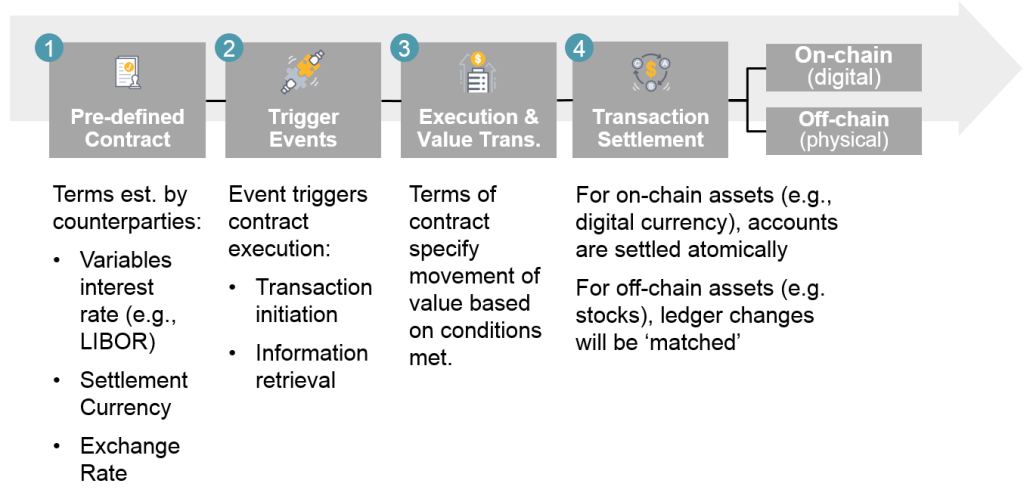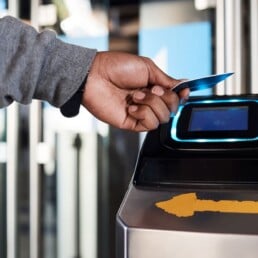Smart Blockchain Contracts: Are We Finally Going Paperless?
Introduction
One of the most intricate topics emerging within the blockchain ecosystem are smart contracts. In essence, a smart contract is a computer program, whose code is stored in a distributed blockchain structure, and that directly controls some kind of digital asset (if some condition W happens, then the application autonomously transfers amount X from party Y to party Z). Furthermore, instead of relying on an intermediary, the program determines autonomously if contractual conditions were met (e.g., by retrieving external data such as weather or interest rates using existing, pre-defined APIs as a source), and will execute the contract (e.g., money transfer) accordingly. Such smart contacts offer the potential to facilitate or fully automate processes that are heavily paper-based today, particularly long-winded, expensive legal processes.
THE ETHEREUM REVOLUTION
The Ethereum smart contract implementation has gained the largest momentum so far. The project runs a public blockchain platform (similar to – but separate from – the Bitcoin blockchain) with extensive, Turing-complete smart contract functionality. Several technology companies, including IBM, have started to run pilot projects using the Ethereum infrastructure; even Microsoft announced support of the platform on its Azure infrastructure earlier this year. The system itself essentially provides a decentralized virtual machine that can execute peer-to-peer contracts using a cryptocurrency called Ether (ETH), that is used to pay for both the infrastructure (hardware, computing), as well as the contracts’ settlements.
STANDARD-FORM SMART CONTRACTS
As of today, smart contracts are coded manually, describing the individual contract conditions, scenarios, and outcomes. Over time, however, this process could be simplified, and there could be “smart contracts”, standardized across the industry that will have to only be adjusted or tailored with respect to specific use cases. In addition, not all aspects of such a ‘smart contract’ have to be fully automated: one can imagine the inclusion of special scenarios under which the smart contract provides a previously-specified mediator with mitigation authority over the contract (e.g., the funds that are to be transferred). Ultimately, customers should be using blockchain-enabled smart contracts without realizing that they are doing so, or having to care about the specific elements of the underlying technology.
EARLY APPLICATIONS
Below are three examples of smart contracts that are viable today:
- Flight insurance: Using data interfaces (airline information, weather conditions) available today, one can create autonomous Ethereum-based flight insurance contracts.
- Syndicated Loans: An actual multi-party application today are weather-based bonds, powered by publicly-available weather data (using APIs) on the Ethereum platform.
- Music Rights: UJOMusic started a platform allowing the various stakeholders in music productions to be rewarded transparently for sales, based on pre-defined percentages.
Figure 1 below illustrates the essential steps of the execution of a smart contract today; it is crucial to note that while platforms charge transactions fees (‘gas’ in the case of Ethereum) for the execution of contracts, the settlement is not bound to cryptocurrencies (i.e., settlement conditions could be written to involve traditional “off-chain” asset as well):
Figure 1: Key Elements of Smart Contracts

Potential for Disruption
Given its complexity, the challenges faced by an ecosystems for smart contracts exceed the challenges faced by the traditional blockchain ledger by far. The industry is in an embryonic state, and only time can tell what particular applications will ultimately prevail. However, given the reduced time sensitivity for the settlement of more advanced derivatives, smart contracts could bear disruptive potential – and we expect an increase in start-up activity in the space over the next few months.



























